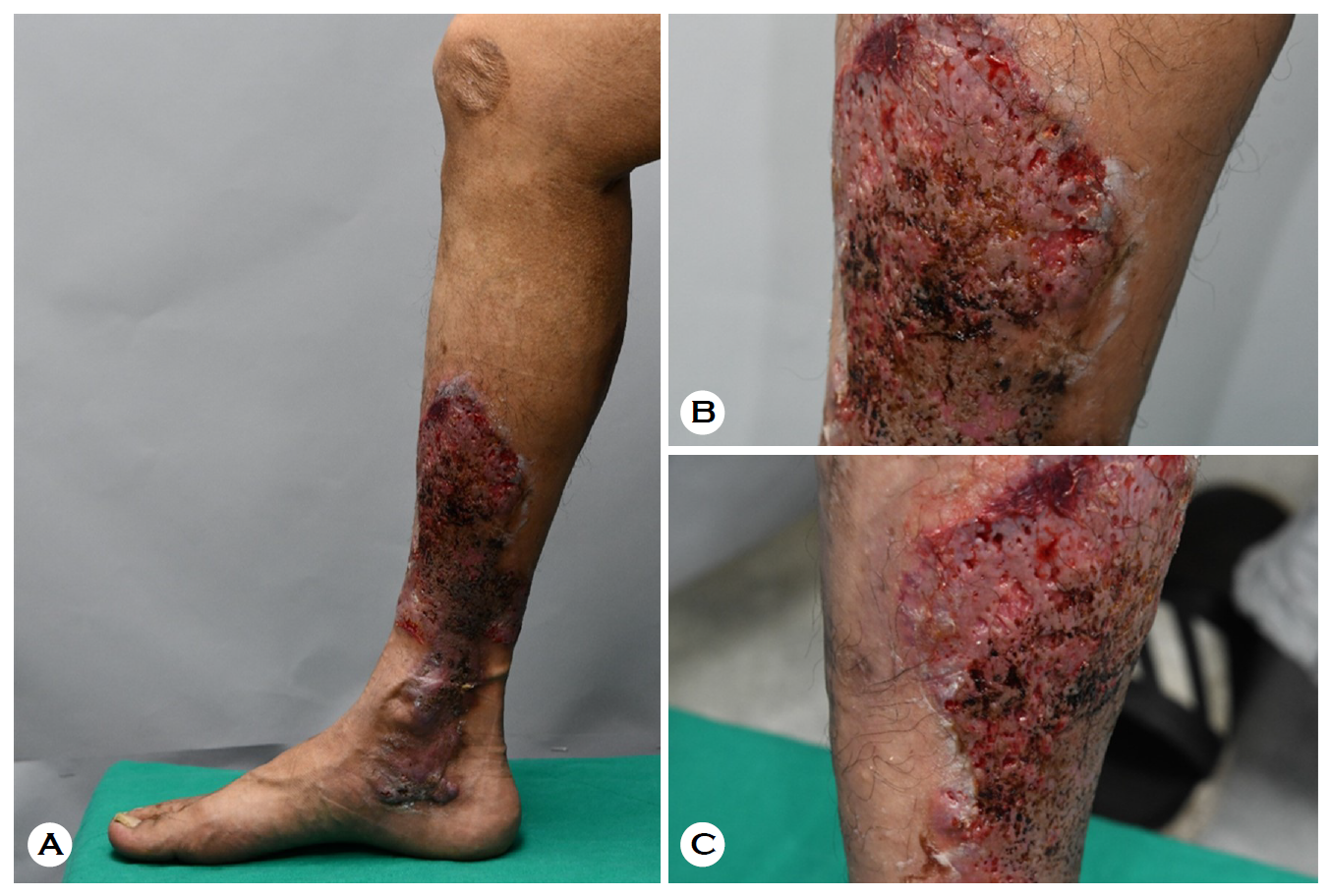pISSN : 3058-423X eISSN: 3058-4302
Open Access, Peer-reviewed

pISSN : 3058-423X eISSN: 3058-4302
Open Access, Peer-reviewed
Jin Seon Bang,Yong Hyun Jang
10.17966/JMI.2023.28.1.14 Epub 2023 April 05
Abstract
Keywords
Corynebacterium striatum Pyoderma gangre- nosum Stenotrophomonas maltophilia
Pyoderma gangrenosum (PG) is a rare neutrophilic dermatosis characterized by rapidly developing painful skin ulcers with undermined borders and peripheral erythema1. The mainstay of treatment is, to begin with fast-acting immuno-suppressive drugs to reduce inflammation followed by additional slow-acting immunosuppressive drugs. However, the use of immune-suppressive medications has been linked to an increased risk of superimposed infections, which can impede wound healing. Herein, we present two bacterial strains found in a patient with PG.
For 1 year, a 35-year-old male was presented to our clinic with multiple enlarging erythematous and eczematous ulcers with crust on his abdomen, back, and lower leg. After being diagnosed with PG at another tertiary hospital, the patient was given systemic corticosteroids to control his symptoms. He had a history of tuberculous lymphadenitis, diabetes mellitus, and hyperlipidemia. Following induction therapy, low-dose systemic corticosteroids, colchicine, mycophenolic acid, and dapsone were administered as a maintenance therapy. Although the lesions repeated improvement and recurrence, they remained relatively in stable condition for 7 years. However, the patient developed a foul-smelling odor from the ulcer on his lower leg, and the lesion worsened with severe pain (Fig. 1). Under the probability of superimposed infection, a wound culture was conducted. The results showed moderate growth of Corynebacterium striatum (C. striatum) and heavy growth of Stenotrophomonas maltophilia (S. maltophilia); therefore, we started antibiotic combination therapy with sultamicillin and minocycline the next day. After several weeks of antibiotic therapy, the wound smelled better and the skin lesions improved gradually without increasing the immunosuppressive drug dose.
Infection aggravates PG by recruiting more neutrophils through inflammatory cytokines. Furthermore, web-like neu- trophil extracellular traps released by neutrophils in response to the infection are toxic to surrounding cells and play a role in the development of PG lesions2.
C. striatum is a part of the normal skin and mucous membrane flora in humans and is widely disseminated in the environment3. As a result, when cultured in the skin, they have generally been regarded as a contaminant. Alternatively, S. maltophilia can cause cutaneous infection, particularly in patients who are immunocompromised4. Lesions can be localized or involve multiple body sites, including the ex- tremities. Initially, the lesions are tender and annular in shape with a violaceous center, gradually progressing to deep-tissue infection with central necrosis. Owing to these clinical char- acteristics, it is necessary to differentiate this infection from the aggravation of PG. Because they have an ammonia odor on blood agar5, infected lesions may be foul smelling as well, and the smell could be a distinguishing factor. Although trimethoprim-sulfamethoxazole (TMP-SMX) has the most potent and reliable against S. maltophilia in vitro, the patient's antibiotic susceptibility test was confirmed to be resistant to TMP-SMX. Instead, several β-lactams and minocycline, which we used, have also been found to have activity against S. maltophilia.
In aggravated PG, especially odorous PG, we should check whether there is a new superimposed infection and quickly identify the pathogen through the wound culture. Furthermore, more research on the role of S. macrophilia infection in patients with PG is required.

References
1. Maverakis E, Marzano AV, Le ST, Callen JP, Brüggen MC, Guenova E, et al. Pyoderma gangrenosum. Nat Rev Dis Primers 2020;6:81
Google Scholar
2. Croia C, Dini V, Loggini B, Manni E, Romanelli M, Migliorini P. Evaluation of neutrophil extracellular trap deregulated formation in pyoderma gangrenosum. Exp Dermatol 2021;30:1340-1344
Google Scholar
3. Song SA, Shin JH. Microbiological characteristics of Coryne- bacterium striatum, an emerging pathogen. Hanyang Med Rev 2018;38:93-98
Google Scholar
4. Safdar A, Rolston KV. Stenotrophomonas maltophilia: changing spectrum of a serious bacterial pathogen in patients with cancer. Clin Infect Dis 2007;45:1602-1609
Google Scholar
5. Said MS, Tirthani E, Lesho E. Stenotrophomonas malto- philia. 2022 Jun 21. In: StatPearls [Internet]. Treasure Island (FL): StatPearls Publishing, 2022
Google Scholar
Congratulatory MessageClick here!